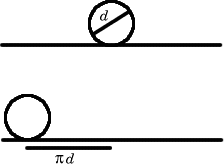Stonehenge
Problem
In times gone by people moved very heavy stones by using logs as rollers. Assuming all the logs have the same radius and that the logs roll and do not slide explain why the stone moves in the direction the people push it twice as fast as the logs. (Try a similar experiment yourself, for example with some pencils and a heavy book, and you will find you leave the 'logs' behind at the back and have to move them into position in front of the 'stone'.)

Getting Started
Student Solutions
Here's a good clear explanation from Jack of Madras College.
Consider the movement of the block relative to the logs:
When the log makes one revolution it travels ${\pi}d$ metres. As the block is in contact with the logs, it moves ${\pi}d$ metres along the horizontal plane.

Therefore, the block moves ${\pi}d$ metres relative to the logs.
Now consider the movement of the logs relative to the ground:
When the log makes one revolution it rotates ${\pi}d$ metres. As it is in contact with the ground it moves ${\pi}d$ metres along the horizontal plane.
Therefore, the log moves ${\pi}d$ metres relative to the ground.
